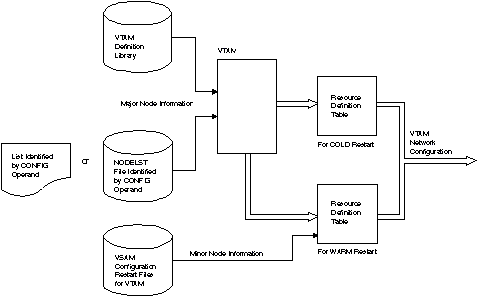 z/OS Communications Server: SNA Network Implementation Guide
z/OS Communications Server: SNA Network Implementation Guide
 z/OS Communications Server: SNA Network Implementation Guide
z/OS Communications Server: SNA Network Implementation Guide
|
Previous topic |
Next topic |
Contents |
Contact z/OS |
Library |
PDF
Using configuration restart warm start z/OS Communications Server: SNA Network Implementation Guide SC27-3672-01 |
|
|
As shown in Figure 1, if you specify the WARM operand when activating a major node, VTAM® updates its resource definition table from information in the VSAM configuration restart file for the major node. VTAM then restores the minor nodes within the major node to their status before the failure or deactivation. Also shown in Figure 1, if you specify the WARM start option when starting VTAM, VTAM can update its resource definition table from information in the NODELST file. Figure 1. Restoring resource definitions with configuration
restart and NODELST files
 If you specified a NODELST file when the network was last started, the major nodes that were active and the DR files that were applied when the failure occurred can be reactivated by specifying the NODELST file name on the CONFIG operand during a warm start. If you used the VARY ACT,UPDATE technique of dynamic reconfiguration, major node definitions reflect dynamic reconfiguration changes, and the changes are reestablished when the major node is activated during NODELST processing. See Dynamic reconfiguration and change of operands for more information about the techniques that are available for dynamic reconfiguration. Note: Dynamically defined independent logical units cannot be warm
started.
For an example of how NODELST and configuration restart files are used, see Configuration restart example. VTAM uses the VSAM configuration restart files to record changes to the named minor nodes within the major nodes (unnamed minor nodes are not checkpointed). If the VSAM files are defined, the VTAM operator can specify how VTAM is to use the files for configuration restart. To associate VSAM configuration restart files with individual major nodes, code the CONFGDS and CONFGPW operands on the definition statements for the major nodes. A NODELST file can be defined to record which major nodes and DR files are active in the network. A NODELST file is specified with the NODELST start option. You can use either or both of these file types when using configuration restart. If the user defines configuration restart files, VTAM provides two additional forms of recovery: manual switching to a backup host processor and manual switching to a backup communication controller. If you do not associate a configuration restart file with a major node, or if the configuration restart file is empty, then the major node is not activated to its prior status. If NODELST is in effect and you are doing a warm start of a configuration that has been dynamically reconfigured using the VARY DRDS technique, the DR statements that are processed again as part of the start process might fail because the nodes they specify became active earlier in the process. 


|
 Copyright IBM Corporation 1990, 2014 Copyright IBM Corporation 1990, 2014 |